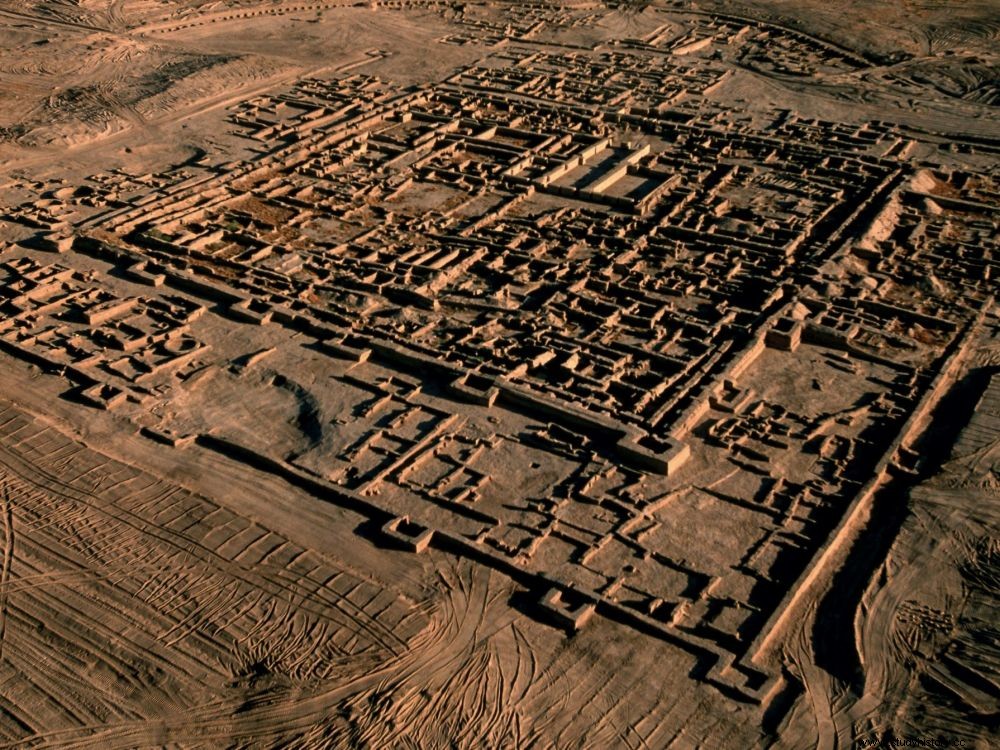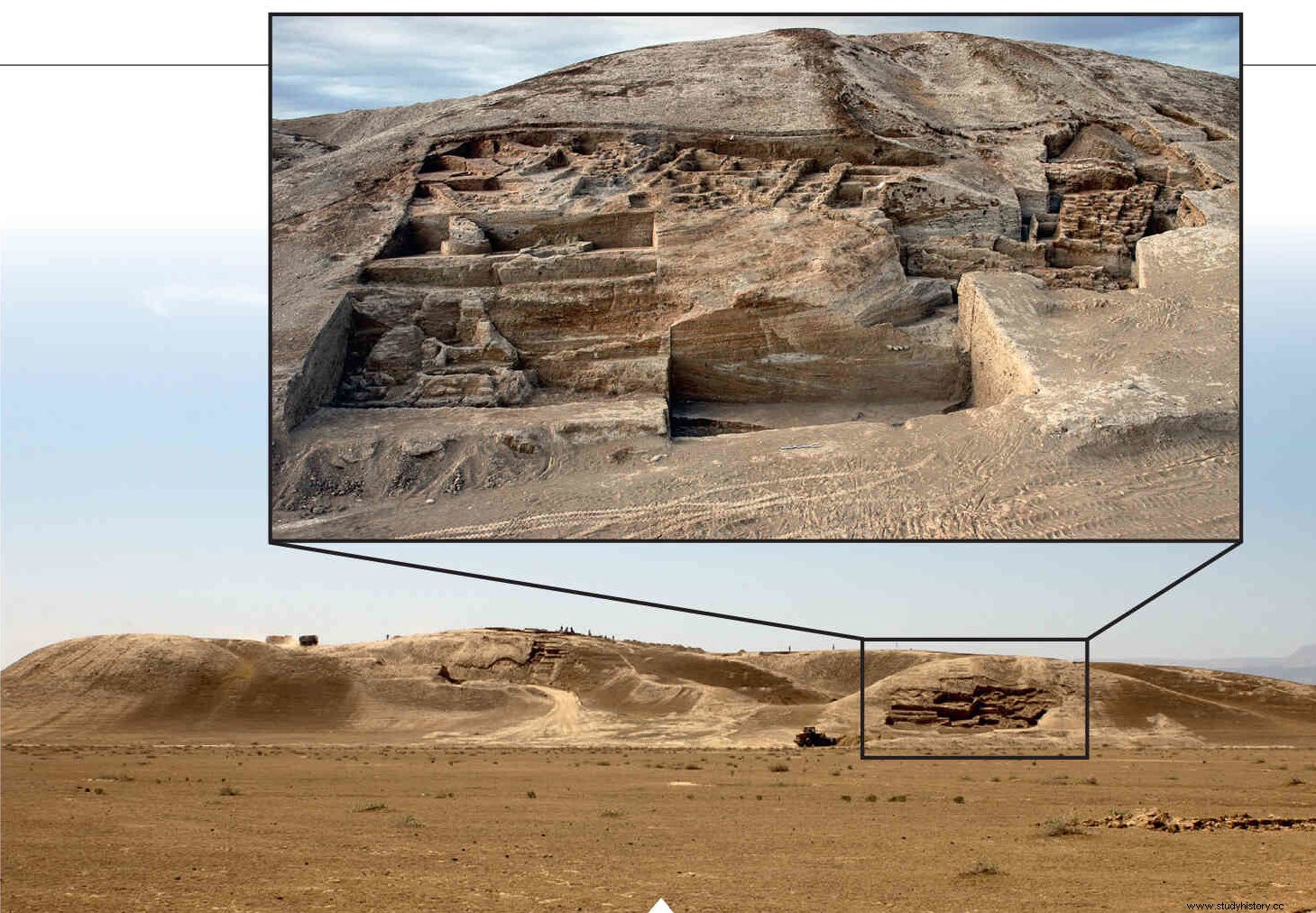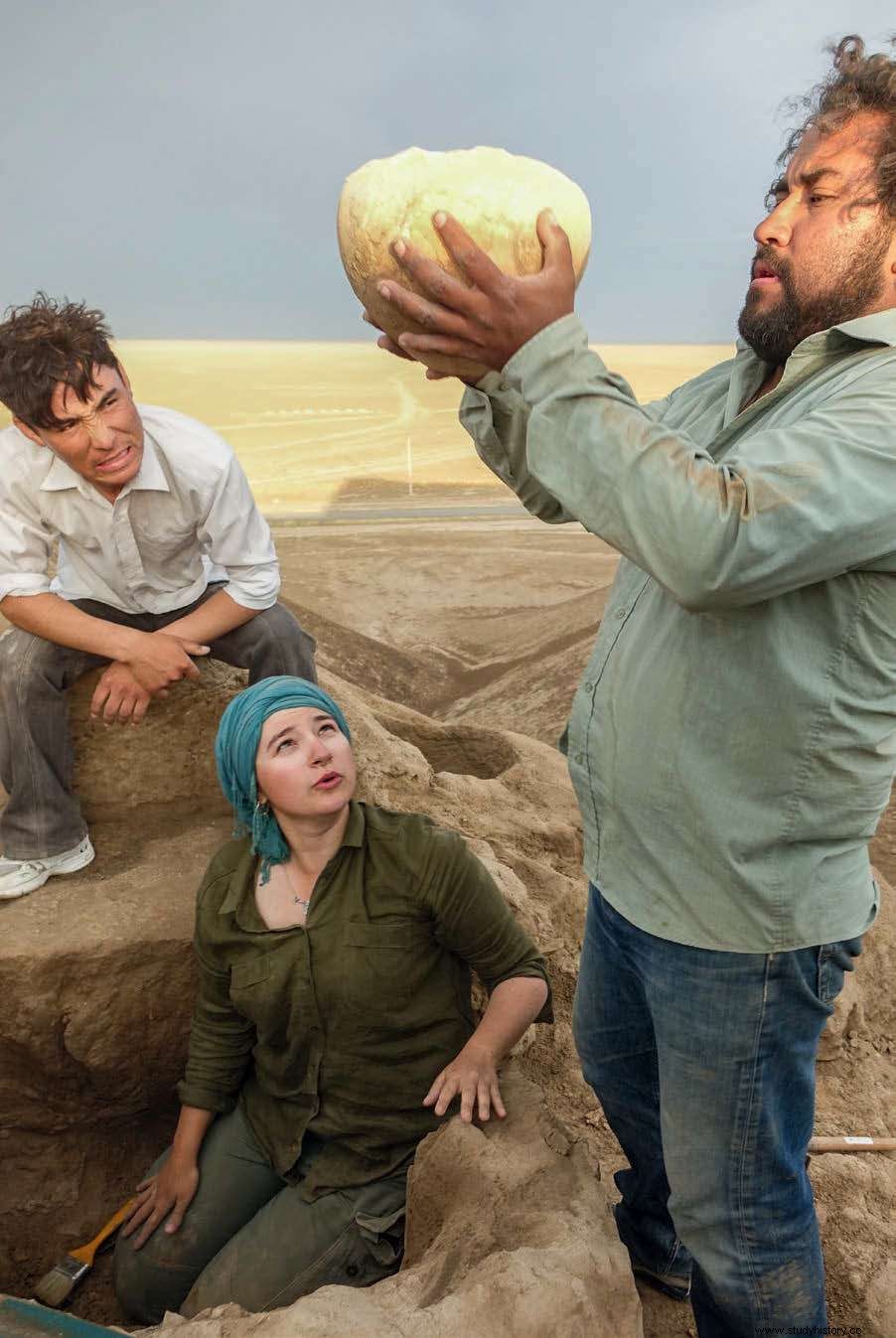3500 years ago, in Central Asia, the civilization of the Oxus died out. Who were these Bronze Age populations? How did their rich cities disappear? The results of archaeological excavations carried out by a Franco-Turkmen team provide the first elements of an answer.

With its temples and palaces, the city of Gonur depe, today in Turkmenistan, was arguably the capital of the Oxus civilization.
This article is from the magazine Sciences et Avenir - La Recherche n°897 dated November 2021.
In this isolated region of Turkmenistan, camels are sometimes seen at the foot of a huge mound. Chewing on rare clumps of grass, they have long been part of the landscape. Resembling the hump of one of these dozing camelids, the mound of the "Great Hill", Ulug dépé, crushes with its stocky relief the desert plain located 175 km south-east of Ashgabat, the capital of country.
Now 80% occupied by the Karakum Desert, this Central Asian country, little known to Westerners, has seen the emergence of important civilizations. Like the mysterious civilization of the Oxus. Baptized with the ancient name of the Amou-Daria river, it developed for 800 years at the end of the 3 millennium, between 2300 and 1500 BC between the Iranian plateau, the Caspian Sea and the mountainous region of the Hindu Kush in northern Afghanistan. It was discovered in the 1970s, with in particular the identification of the royal city of Gonur dépé, probably its capital. In the 1980s, other cities belonging to this same civilization were revealed by the work of Soviet researchers:Altyn dépé (Turkmenistan), Dzhar-kutan (Uzbekistan) or Dashly (Afghanistan).
These discoveries made it possible to paint a first portrait of this civilization, initially baptized, with the somewhat poetic name "Bactro-Margian archaeological complex", in reference to the region, by its discoverer, the Russian archaeologist Viktor Sarianidi (1929-2013 ). A settled society of farmers and herders that initially developed in mud-brick villages, built on vast fertile lands along the great rivers of Central Asia, where the inhabitants raised cattle, sheep, goats, horses, camels and practiced irrigation.
This article is from the magazine Sciences et Avenir - La Recherche n°897 dated November 2021.
In this isolated region of Turkmenistan, camels are sometimes seen at the foot of a huge mound. Chewing on rare clumps of grass, they have long been part of the landscape. Resembling the hump of one of these dozing camelids, the mound of the "Great Hill", Ulug dépé, crushes with its stocky relief the desert plain located 175 km south-east of Ashgabat, the capital of country.
Now 80% occupied by the Karakum Desert, this Central Asian country, little known to Westerners, has seen the emergence of important civilizations. Like the mysterious civilization of the Oxus. Baptized with the ancient name of the Amou-Daria river, it developed for 800 years at the end of the 3 millennium, between 2300 and 1500 BC between the Iranian plateau, the Caspian Sea and the mountainous region of the Hindu Kush in northern Afghanistan. It was discovered in the 1970s, with in particular the identification of the royal city of Gonur dépé, probably its capital. In the 1980s, other cities belonging to this same civilization were revealed by the work of Soviet researchers:Altyn dépé (Turkmenistan), Dzhar-kutan (Uzbekistan) or Dashly (Afghanistan).
These discoveries made it possible to paint a first portrait of this civilization, initially baptized, with the somewhat poetic name "Bactro-Margian archaeological complex", in reference to the region, by its discoverer, the Russian archaeologist Viktor Sarianidi (1929-2013 ). A settled society of farmers and herders that initially developed in mud-brick villages, built on vast fertile lands along the great rivers of Central Asia, where the inhabitants raised cattle, sheep, goats, horses, camels and practiced irrigation.

A movable treasure as rich as that of Mesopotamia
But what were the origins of this civilization? And why did its flourishing cities, occupied in the Bronze Age by thousands of inhabitants, suddenly give way to more modest habitats? To try to answer these questions, the specialists looked at the two main regions favorable to human settlements:the Margiane zone, in the north-east of Turkmenistan, and that stretching at the foot of the Kopet-Dagh mountains, cradle of Ulug Dépé. This imposing site, 30 m high, has indeed an exceptional advantage for an archaeologist:it has been occupied without interruption from the end of the Neolithic period (5000 BC) until the Middle Iron Age (6th century BC) and later until the Hellenistic and Parthian periods (3rd century BC-1st century).

The city of Ulug dépé is a unique site:this imposing 30 m high mound was occupied continuously from the end of the Neolithic period (5000 BC) until the Middle Iron Age century BC). Credit:MAFTUR
And this is where the Franco-Turkmen Archaeological Mission (Maftur) headed by Julio Bendezu-Sarmiento has been evolving for almost twenty years, over fifteen hectares. Former director of the French Archaeological Delegation in Afghanistan (Dafa), this researcher of Peruvian origin is now in charge of research within the eco-anthropology team of the CNRS (UMR 7206). "The exceptional accumulation of archaeological layers encountered at Ulug dépé is a unique phenomenon, he explains. In one place it is possible to embrace 5000 years of human occupation! The excavations carried out since 2001 have enabled us to deliver remains of palatial buildings, warehouses, a citadel, ramparts, and above all tons of ceramics and objects in metal, stone, wood and textiles. Remains that were found at the same time in the cities of Mesopotamia and which were thought to be the only region to have them!"
In the oldest layers of Ulug Dépé, those corresponding to the Bronze Age (3rd millennium BC), together with the great palatial buildings and their terraces for religious use, the productions (ceramics, metallurgical , stonework) were of a high technological level, drawing a sophisticated proto-urban society. Large mud-brick gates gave access to a network of interior streets forming vast quarters with palaces and high platforms surmounted by temples and tombs of the elite. "The whole testified to a strongly hierarchical society, with no doubt a system of vassalage of smaller cities ", specifies the archaeologist.
A unique fortified city in Central Asia
But at the end of the Bronze Age, around 1700-1750 BC, signs of crises appeared in urbanization. The Oxus civilization, made up of small kingdoms, began to wither. The whole of the southern zone of Central Asia has seen the arrival and settlement of new populations. "We then noticed a real loss of know-how ", continues Julio Bendezu-Sarmiento. What was previously produced in an almost industrial way, such as ceramics, has been replaced by more rustic productions. Most of the metal objects have disappeared. "And it is around these changes that discussions stumble among specialists ", adds Julio Bendezu-Sarmiento. In Central Asia, unlike Mesopotamia, there are no written texts to elucidate the causes of these upheavals.
Continuing the ascent to the top of the site, the researchers first unearthed the remains of a citadel built around 1000 BC. But the imposing 40 m side building which dominated the city was not alone. A second citadel was then cleared. "As early as 2003, electromagnetic prospecting made us realize that everything was very complex. In Ulug dép, we thus discovered a city with an upper town overseen by a citadel and three large buildings, and a lower town with streets and other important buildings. Above all, the city was surrounded by a wall with three large defense gates. A unique case in Central Asia ", specifies Julio Bendezu-Sarmiento. "Unfortunately, we find little archaeological material in these probably looted levels. And there is almost no more metal. They are also devoid of graves ", laments the archaeologist. As in all of Central Asia. In the layers of the Bronze Age, around 2000 BC, necropolises could have up to 5000 tombs.
Witness to the height of the civilization of the Oxus, the site of Ulug dépé has thus yielded rich burials, such as that of a couple whose remains of the wife were found adorned with a belt of limestone beads associated with prestigious objects, ceramic vases, and others in alabaster probably from Iran or Baluchistan, in present-day Pakistan; while that of the man carried gold beads, lapis lazuli from Afghanistan, carnelian from the Indus Valley, and even agates.

Eight Alabaster Vases were found in the "tomb of the princess" excavated in the northeastern part of Ulug dépé (here one of them held by Julio Bendezu-Sarmiento). Credits:JULIO BENDEZU-SARMIENTO/MAFTUR
Funeral practices have evolved
But these funeral practices will change radically. In Ulug dépé, as in other places, the bodies of the deceased were simply deposited outside the city wall. "These practices began in Central Asia during the second half of the 2nd millennium BC (around 1500 BC; editor's note)", explains Julio Bendezu-Sarmiento, who talks about "cultures sine sepulchro", that is to say without burials. "The bodies were left to be cut up by the animals. In excavations dating back to the Early Iron Age, we have found individuals without heads, shoulders, arms, etc. At Ulug dépé, osteological analyzes indicate that at the habitat site, 99% of the bones collected were from wildlife and only 1% from human bones. To top it all off, in 2020, the only human bones we encountered were outside the northern boundary wall of the site, in what could be described as garbage cans! "This passage from the burial of the dead to the benefit of the exposure of the bodies in the open air would have been the harbinger of the arrival of a monotheistic religion which will develop in the millennium before our era, a form of Proto-Zoroastrianism (see box below)."In Zoroastrianism as we know it today, the bodies of the deceased are not buried, for they must not defile the earth, the fire, the air and water. The body decomposes, eaten by scavengers ", specifies Julio Bendezu-Sarmiento. Hence those abandoned to be devoured by animals. A practice that has lasted for more than a millennium.
Remains in the open air so as not to soil the ground
Zoroastrianism, from the "prophet" Zarathoustra from which it takes its name, would have prohibited the burial of bodies. Accused of soiling the ground, the decomposing remains were left in the open air to be devoured by scavengers. A vision that horrified Alexander the Great when he arrived in what is now Afghanistan in the 4th century BC. ), the Macedonian conqueror had been revolted by the sight of human bones that dogs were fighting over… Alexander had these practices banned. In Central Asia, burials did not reappear until after the Hellenistic conquest.
A collapse caused by a demographic drop?
At the same time that the bodies of humans were no longer buried, a "collapse" was also observed on the side of the great palaces and large cities which disappeared in turn. They are then replaced by villages of lesser importance. A regional potentate certainly still existed, but he no longer showed any signs of wealth. To explain this decline, Russian archaeologists had initially hypothesized the mass arrival on the territory of the Oxus civilization of warlike populations from northern regions. Others have suggested that disturbances in the balance of the socio-economic system have been induced by the increasing aridity of the climate and the consequent decrease in agricultural potential.
After rather humid climatic conditions, a strong drying of the climate would have occurred around 2000-1800 BC, gradually reducing the flow of the rivers, and constantly moving the sands of Karakum. However, commercial exchanges had a large part in the development of the civilization of the Oxus; in particular an intensive trade with the Near East and the Indus civilization of raw materials such as ores, in the forefront of which tin and lapis lazuli. "Upheavals related to the tin trade could then have caused the decline of the Oxus civilization ", believes the archaeologist.
Alternatively, the concentration of populations in urban centers could have reached a critical level. Frequently mentioned to explain the collapse of civilization, the hypothesis of the demographic catastrophe is often linked to the occurrence of ecological problems following the aridification of the soil or the disappearance of waterways. Finally, the civilization of the Oxus could have disappeared following internal socio-political upheavals (conflicts between elites, class struggle, social dysfunction). Even today, the final period remains rather obscure. "Only the continuation of archaeological excavations will allow us to better understand the evolutionary processes of this civilization, until its definitive replacement in the Early Iron Age by the culture sine sepulchro", concludes Julio Bendezu-Sarmiento.
